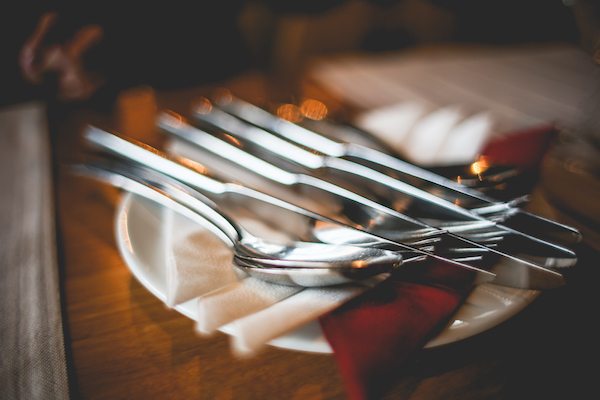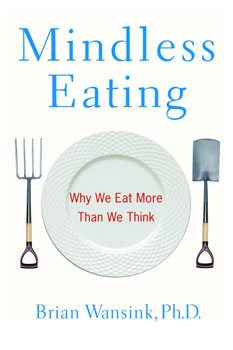This month we have talked all about how to adopt healthier eating habits from nine to five. When you are busy and stressed at work your mind can be pulled a million ways, and it is easy to each without thinking about it.
Have you ever found yourself reaching into the candy dish at work, and being stunned that you single-handedly emptied it over one afternoon? It’s very easy to over eat when we are distracted and not thinking about it. The key to curbing mindless eating is to be aware of when and why it happens.
Tips and Tricks to Stop Mindless Eating
Several years ago I read the book Mindless Eating, and it honestly revolutionized my awareness of how much we’re eating, what we actually put in our mouths, and why we do so. The author, Brain Wansink, is a food psychologist, and a director of the Cornell Food and Brand Lab. He studies peoples’ eating behaviours and the factors that influence their intake. His book describes the findings from the studies he conducted in his lab, and relates them to our everyday eating behaviours. It’s a really cool book and an easy read – I totally recommend it! The point of it…Being aware of your mindless eating behaviours and the things that trigger them helps you to control and prevent over eating.
I have always been against strict, restrictive diets to lose weight. They leave us feeling deprived and set people up for failure. The philosophy to weight loss in Mindless Eating is all about making small changes to your eating behaviours; a philosophy I completely agree with and promote!
These strategies encourage you to still enjoy the foods you love but to lose weight by being aware of instances where you overeat and provides strategies to prevent it. I strongly encourage clients who are looking to lose weight to read this book, as it provides some great strategies to lose weight or maintain a healthy weight in a really positive and helpful way. Below are a few of the best tips, strategies and studies that stuck out to me in this fantastic book. This is by no means an extensive list, so I encourage you to give Mindless Eating a read!

The Mindless Margin
Brian Wansink refers to the “mindless margin” throughout the book. This is a zone of unconscious overeating or under eating that occurs every day. When you start a new “diet” that requires you to dramatically decrease your food intake, you are left feeling tired, weak and famished. The same is true for the opposite, after a thanksgiving dinner we are well aware that we have overate and as a result we feel bloated and full. In between these two extremes is the “mindless margin.” Over or under consuming 100 calories each day may not be something we notice on a daily basis, but it is something that can lead to a 10 lb loss or 10 lb gain when accumulated over a year’s time. The book encourages you to make small 100-200 calorie changes, which will have long term effects for weight loss, but won’t leave you feeling deprived and defeated.
Reengineering Strategy 1: Think 20% Less
In North America we stop eating when we are full, in other countries, where the rates of obesity and chronic diseases are lower, they tend stop eating why they are no longer hungry. There is actually a large calorie difference between eating until you’re full and just eating until satisfied. In North America we don’t use satiety (aka fullness) as a cue to stop eating, rather we often use external cues such as our plate being empty, bag of chips being gone, or a TV show ending.
Study (The Bottomless Bowl Soup Study): a soup bowl was designed to automatically refill. Those with refillable bowls ate 73% more soup than those who had normal bowls. This study proves that we rely on external cues, such as emptying the bowl to stop eating, not on our bodies’ natural feelings of hunger and fullness. Soooo interesting right?
Tip #1- Think 20% less: dish out 20% less than you normally want to eat. Allow yourself to finish this portion slowly, like over 10-15 minutes, then try and assess how full you feel before getting more.
Reengineering Strategy #2: See All You Eat
The phrase “out of sight and out of mind” rings true for food intake. It’s pretty easy to forget how much we have eaten , once it is in our stomach.
Study: Two groups were invited to a restaurant to watch a sports game. At the first table, the server was instructed to clear the table of chicken wing bones once eaten. At the second table, the server left the plates full of eaten chicken wings. The second table ate far fewer chicken wings, because they were reminded of how much they had eaten by seeing the leftover bones.
Tip #2 – See it Before you eat it: put everything you want to eat on your plate before you start eating, this is really helpful for snack foods. Those that pre-plate their food, ate about 14% less. Putting it on the plate and seeing what you are going to eat helps decide how much is too much, than if you were eating straight from the box.
Tip #3 – See it While you eat it: If possible leave the remnants of what you’ve eaten like bones egg shells, etc.. Ask the server not to clear your empty soda glass, or choose to leave the empty candy wrappers on your desk. This might drive your server crazy! But these things serve as a reminder of what you have eaten so far.

Reengineering Strategy #3: Be Your Own Tablescaper
The way a table is set, as well as the types of dishes and utensils you use can impact how much you eat. Your home tablescape is full of hidden food persuaders and making simples changes can decrease how much you eat.
Study: On arrival participants were led to one of two rooms to get snacks before a party. The first room had two huge gallon bowls of Chex mix. In the second room everything was the same, except the Chex Mix had been put in four half-gallon bowls. Those who took from the two large gallon bowls of Chex mix took 53% more than the group in the second room who took from four bowls.
Tip #4 – Mini-Size your Boxes and Bowls: The bigger the package you pour from, the more you will eat. The smaller the serving dish or box, the less you take, and the less you eat.
Tip #5 – Become an Illusionist: A smaller serving on a smaller plate looks like a lot more, than a small serving on a large plate. Using smaller bowls and plates can trick your mind it think you’re getting a bigger portion.
Reengineering Strategy #4: Make Overeating a Hassle, Not a Habit
Make the unhealthy choice the more difficult choice and the healthy choice the easier one. Convenience is a major determinant in the food we eat, by making unhealthy food convenient and accessible we are more likely to give in to the temptation.
Study: Secretaries were either given clear or opaque candy dishes. Those with clear/translucent candy dishes, who could actually see the candy, ate 71% more than those white opaque dishes. When the candy was out of sight, it was out of mind and people ate WAY less.
Tip #6 – Move Things Out of Sight/Reach: Move the candy dish across the office, the plate of warm cookies off the counter, or the chips into the cupboard. We are less likely to indulge if it is out of sight not reminding us that it’s there.
Tip #7 – De-convenience Tempting Foods: Don’t make things easy. Keep healthy, fresh food more available and move the box of cookies to the cupboard above the fridge, or the ice cream to the downstairs freezer. The more work it requires, the less likely we are to eat it.
I know it can be difficult to rule out your favourite treat when you are trying to lose weight, but by reengineering your personal food environment you can eliminate mindless munching while still enjoying the foods you love. And still enjoy that special treat from time-to-time when you really want it… not just because you’re not thinking 😉
Much Love and Good Eating,
Stephanie and The Team

